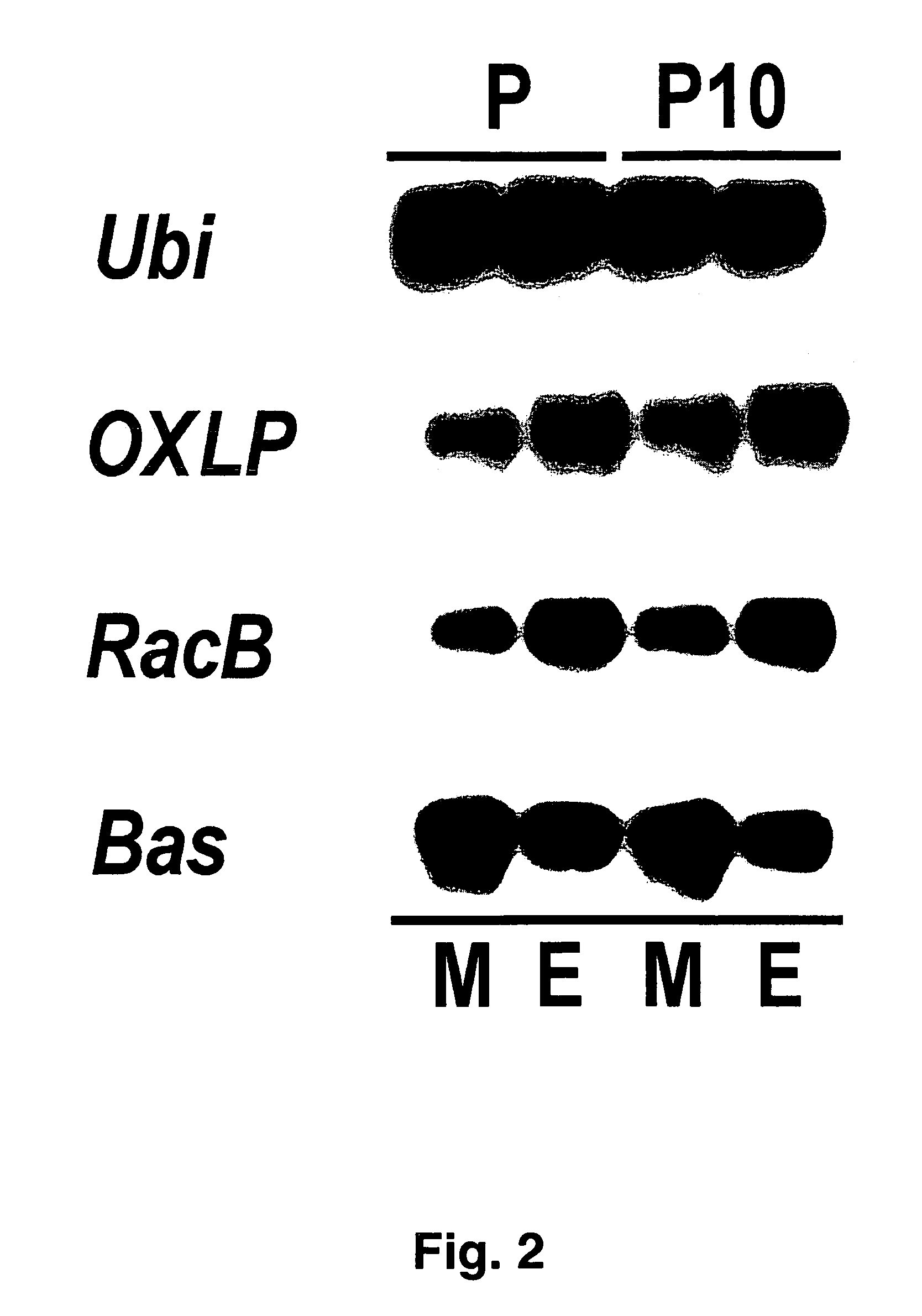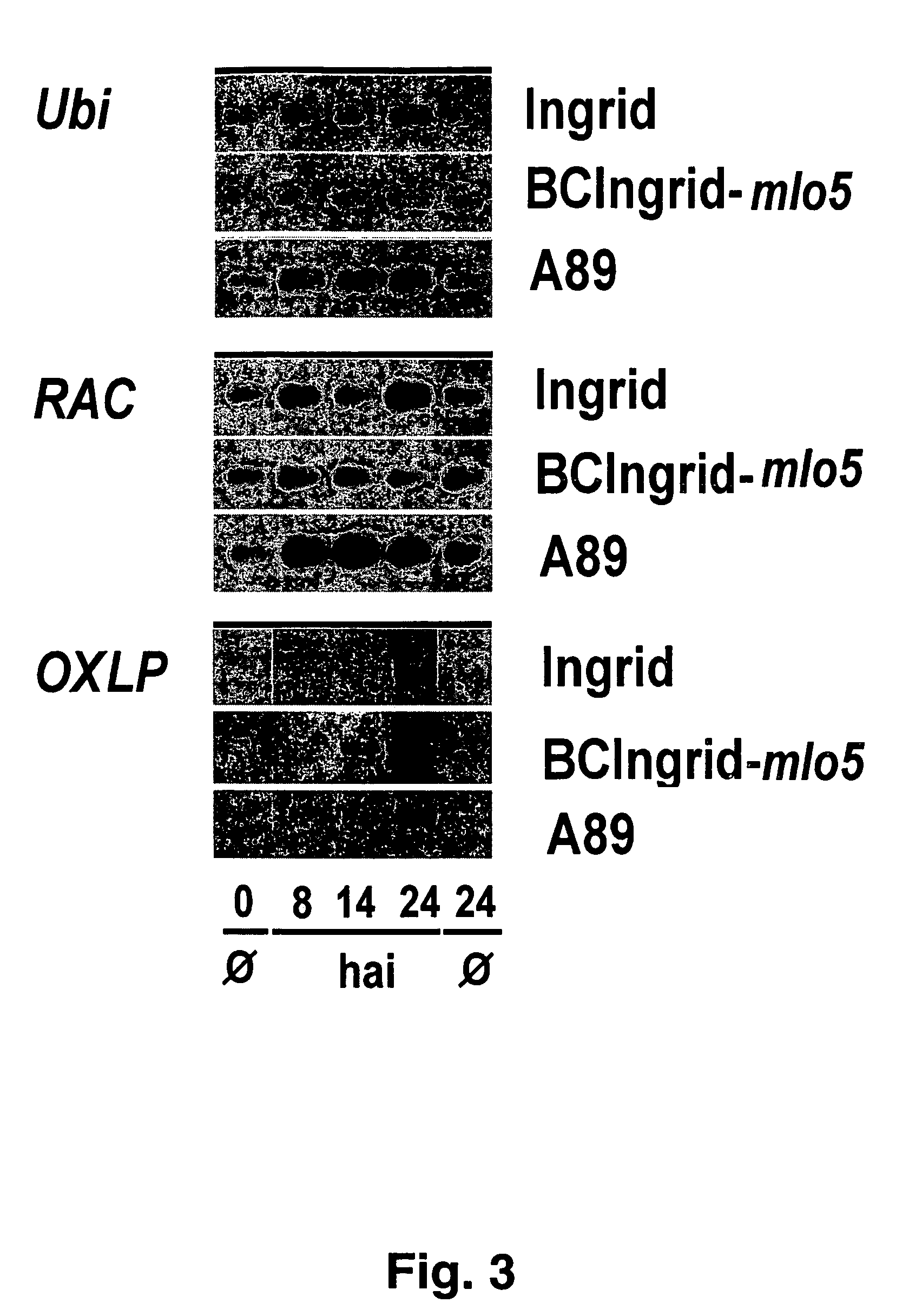Nucleic acid sequences and their use in methods for achieving pathogen resistance in plants
a technology of nucleic acid sequences and pathogen resistance, applied in the field of racb cdna sequences, can solve the problems of insufficient natural defense mechanisms of plants against pathogens, many billions of us$ in annual yield losses, and most of the approaches described only offer resistance, so as to reduce the expression of racb proteins in cells, generate or increase resistance to at least one pathogen, effect of reducing the amount of racb proteins
- Summary
- Abstract
- Description
- Claims
- Application Information
AI Technical Summary
Benefits of technology
Problems solved by technology
Method used
Image
Examples
example 1
Plants, Pathogens and Inoculation
[0327]The barley variety Ingrid is from James McKey, University of Uppsala, Sweden. The variety Pallas and backcrossed line BCIngrid-mlo5 was donated by Lisa Munk, Department of Plant Pathology, Royal Veterinary and Agricultural University, Copenhagen, Denmark. Its production has been described (Kølster P et al. (1986) Crop Sci 26: 903-907). Line A89 was provided by Paul Schulze-Lefert (Max-Plank-Institut für Züchtungsforschung, Cologne, Germany).
[0328]Unless otherwise specified, the seed which had been pregerminated on moist filter paper for 12 to 36 hours in the dark was sown along the edge of a square pot (8×8 cm; 5 kernels per pot) in Fruhstorfer soil, type P, covered with soil and watered regularly with tap water. All of the plants were cultured in controlled-environment cabinets or chambers for 5 to 8 days at 16 to 18° C., 50 to 60% relative atmospheric humidity and a 16-hr-light / 8-hr-dark rhythm at 3000 or 5000 lux (photon flow density 50 and ...
example 2
[0332]Total RNA was extracted from 8 to 10 primary leaf segments (length 5 cm) by means of “RNA extraction buffer” (AGS, Heidelberg, Germany).
[0333]To this end, the central primary leaf segments 5 cm in length were harvested and homogenized in liquid nitrogen in mortars. The homogenate was stored at −70° C. until the RNA was extracted.
[0334]Total RNA was extracted from the deep-frozen leaf material with the aid of an RNA extraction kit (AGS, Heidelberg). To this end, 200 mg of the deep-frozen leaf material were covered with 1.7 ml RNA extraction buffer (AGS) in a microcentrifuge tube (2 ml) and immediately mixed thoroughly. After addition of 200 μl of chloroform, the mixture was again mixed thoroughly and shaken for 45 minutes on a horizontal shaker at 200 rpm at room temperature. To separate the phases, the tubes were subsequently centrifuged for 15 minutes at 20 000 g and 4° C., and the upper, aqueous phase was transferred into a fresh microcentrifuge tube, while the...
example 3
Cloning the Barley RacB cDNA Sequence
[0338]The cDNA fragments required for isolating the HvRacB cDNA, cloning it, sequencing it and generating probes were obtained by means of RT-PCR using the “One Step RT-PCR Kit” (Life Technologies, Karlsruhe, Germany or Qiagen, Hilden, Germany). To this end, total RNA from barley seedlings was used as template.
[0339]The RNA was isolated from Pallas 3, 5 and 0.7 days after germination. Moreover, RNA was isolated from Pallas and the backcrossed lines with mlo5, Mlg or Mla12 1, 2 and 5 days after inoculation with BghA6 on day 7 after germination. The following primers are used for the RT-PCR:
[0340]
ONP-15′-GGATCCGATGAGCGCGTCCAGGTT-3′(SEQ ID NO: 10)andONP-25′-GTCGACCTTCGCCCTTGTTCTTTGTC-3′(SEQ ID NO: 11)
1000 ng of total RNA, 0.4 mM dNTPs, in each case 0.6 mM OPN-1 and OPN-2 primer, 10 μl of RNase inhibitor and 1 μl of enzyme mix in 1×RT buffer (One Step RT-PCR Kit, Qiagen, Hilden) were employed for each reaction (25 μl batch).
[0341]The following temper...
PUM
| Property | Measurement | Unit |
|---|---|---|
| resistance | aaaaa | aaaaa |
| nucleic acid | aaaaa | aaaaa |
| pathogen resistance | aaaaa | aaaaa |
Abstract
Description
Claims
Application Information
 Login to View More
Login to View More - R&D
- Intellectual Property
- Life Sciences
- Materials
- Tech Scout
- Unparalleled Data Quality
- Higher Quality Content
- 60% Fewer Hallucinations
Browse by: Latest US Patents, China's latest patents, Technical Efficacy Thesaurus, Application Domain, Technology Topic, Popular Technical Reports.
© 2025 PatSnap. All rights reserved.Legal|Privacy policy|Modern Slavery Act Transparency Statement|Sitemap|About US| Contact US: help@patsnap.com



